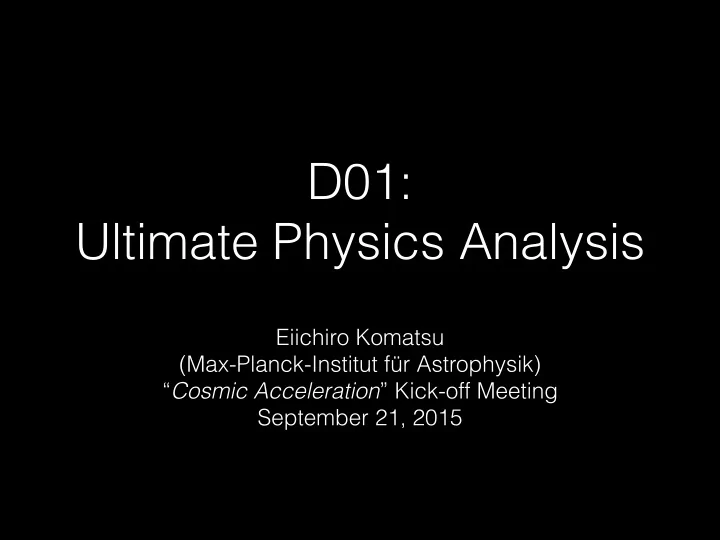

D01: Ultimate Physics Analysis Eiichiro Komatsu (Max-Planck-Institut für Astrophysik) “ Cosmic Acceleration ” Kick-off Meeting September 21, 2015
(笑) D01: Ultimate Physics Analysis Eiichiro Komatsu (Max-Planck-Institut für Astrophysik) “ Cosmic Acceleration ” Kick-off Meeting September 21, 2015
Odeonsplatz Theatinerkirche Rathaus Augstiner am Dom
can start We are hiring! immediately • Munich is a nice place to live and work • Interested in computing, coding, developing tools and softwares? • We want you! • Will issue an announcement soon, but talk to me or send me an email at komatsu@mpa-garching.mpg.de
Ultimate Physics Analysis (D01) • The keyword is “Cross-correlation”
LSS = Large-scale Structure; CMB = Cosmic Microwave Background D01: The Team I. Kayo E. Komatsu K. Takahashi Tokyo Univ. of Tech MPA Kumamoto Univ. • LSS • LSS • LSS • Lensing • CMB • 21cm
LSS = Large-scale Structure; CMB = Cosmic Microwave Background D01: The Team I. Kayo E. Komatsu K. Takahashi Tokyo Univ. of Tech MPA Kumamoto Univ. • LSS • LSS • LSS • Lensing • CMB • 21cm Joint analysis , fully taking into account the mutual cross-correlation
Traditional Method: Auto 2-point Correlation T CMB (1) x T CMB (2) 2 1 Cosmology CMB Joint Constraints 1 2 Cosmology LSS n gal (1) x n gal (2)
Hubble const. H 0 [km/s/Mpc] WMAP, final result CMB +Supernova CMB+LSS CMB Only Dark Matter Density, Ω c h 2
Our Approach: Cross 2-point Correlation CMB T CMB (1) x T CMB (2) 2 1 T CMB (1) x n gal (2) n gal (1) x T CMB (2) n gal (1) x n gal (2) Some cross-correlations have been considered partially 1 2 in the previous study, but never systematically LSS
Bayesian Joint Analysis • Joint analysis including all the cross-correlations between CMB, spectroscopic LSS, and imaging LSS • let us write the conditional probability of cosmological parameters, given the data X, as P(parameters|X) • Conventional method : P(parameters) = P 1 (parameters| CMB ) x P 2 (parameters| specLSS ) x P 3 (parameters| imagingLSS ) • Our approach : P(parameters) = P(parameters | CMB, specLSS, imagingLSS)
What creates cross-correlations? SpecLSS ImagingLSS CMB 3D galaxy map Matter density Lensed CMB Velocity fields map ISW Thermal SZ Kinetic SZ P(param.) = P 1 (param.|CMB) x P 2 (param.|specLSS) x P 3 (param.|imagingLSS) P(param.) = P(param. | CMB, specLSS, imagingLSS)
Tool: Log-normal Simulation • The goal of D01 is to develop tools to determine the cosmological parameters, given the data, including all the cross-correlations • To do this, we need simulations that we understand completely
Tool: Log-normal Simulation • Coming from CMB, I am used to generating Gaussian random fields as a simple simulation tool of cosmological fluctuation fields • Can we do the same for generating density fields of LSS? • Actually, no : the density fluctuation field, δ = ρ / ρ mean –1, must be greater than –1 because the density, ρ , must be positive • For LSS, the variance of δ is of order unity or greater. Therefore, a Gaussian distribution gives regions with δ <–1, which is unphysical
Tool: Log-normal Simulation • So, let us assume that a logarithm of δ , G=ln(1+ δ ) , is Gaussian, instead of δ itself • By construction, δ =exp(G)–1 ≥ –1 is satisfied • This is a toy model, but N-body simulations show that the non-linear, evolved density field is close to a log-normal distribution, as shown by Kayo, Taruya and Suto (2001)
Kayo, Taruya & Suto (2001) Log-normal Distribution from N-body Simulation
Log-normal Simulation? • Everyone is running N-body and/or hydro simulations. Why log-normal simulation now? • The physics inputs to N-body/hydro sims are known, but the outcome is not known because of non-linearities • This will be a problem when we develop tools to infer the parameters: lack of precision model to fit the data
Tool:Log-normal Simulation • But, we know precisely what the outcome of log- normal simulation is. We can fit the log-normal simulation data with no model uncertainty • Understanding the non-linear physics is of course important but it is a separate question, which will be addressed by the other group, e.g., Sugiyama-san’s A03. Complementarity
Example • z=1.3 • b=1.45 • 3666 x 1486 x 734 Mpc 3 /h 3 • 8.35M galaxies k*P(k) wavenumber • Average of 500 realisations
Work Plan Log-normal Simulation ( in hand ) Galaxy Lensing map CMB T&P 21cm distribution ( Kayo ) ( Komatsu ) ( Takahashi ) ( in hand ) P(parameters) = P(parameters | all data) (Komatsu, Kayo, Takahashi, and YOU )
Why should you apply for our advertised postdoc position? • With this work, you can enhance skills for the software development, and analysis of many of the on-going and future observational data (not just one) • 手に職 “Have a marketable skill” • This is precisely the area in which the Japanese community has relative weakness. You can fill the gap!
Recommend
More recommend